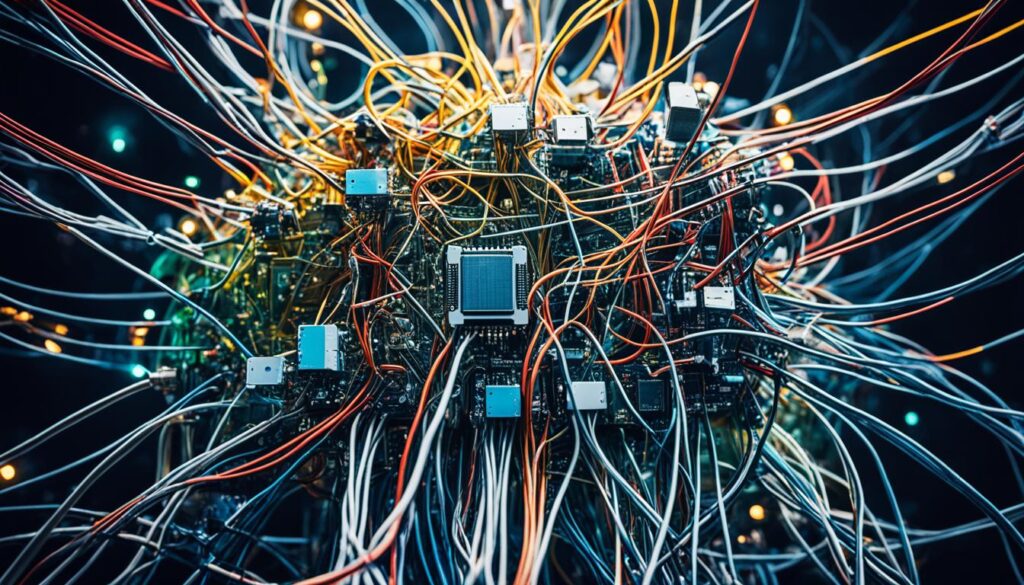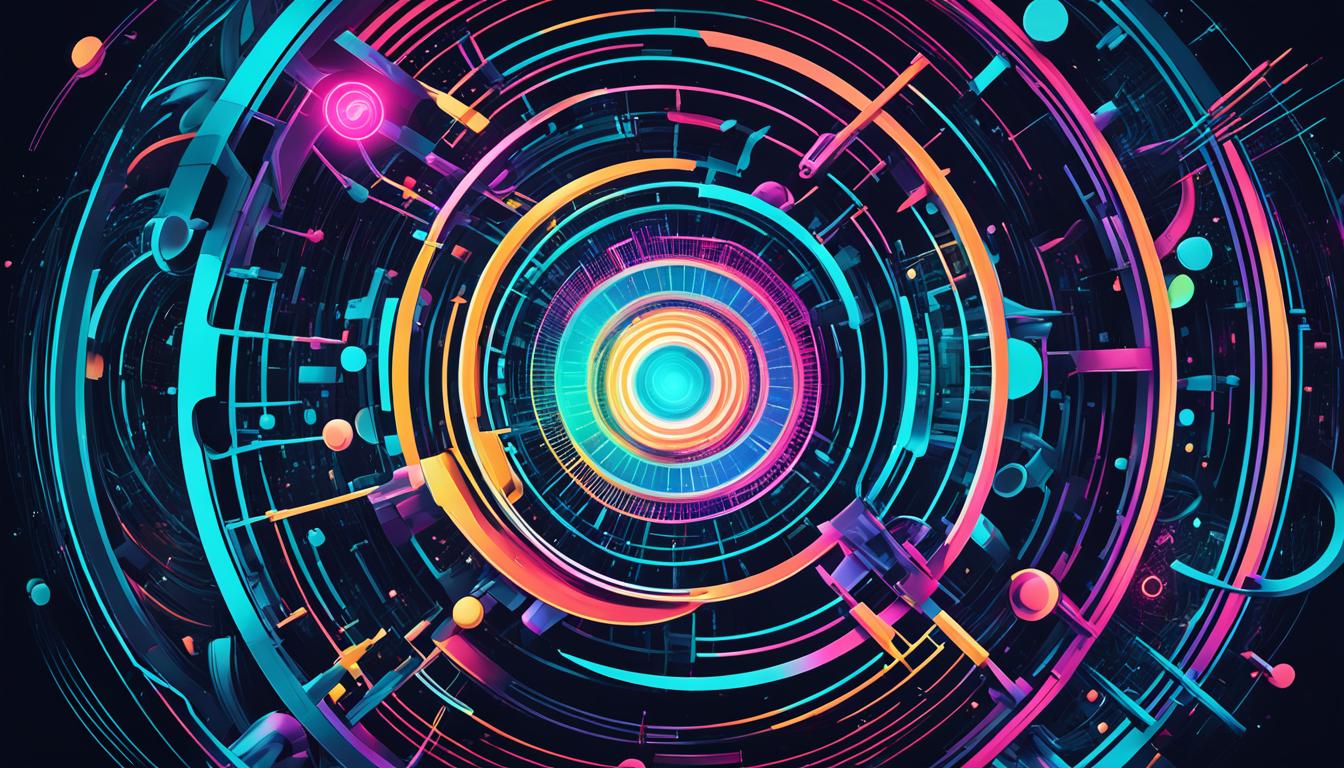In a cosmos where the speed of innovation is as brisk as a quantum particle zipping through space, quantum computing and generative AI stand at the forefront, poised to propel us into a tech renaissance. Here, in this digitized patchwork of possibilities, our conventional computing canvas is expanding with vibrant swathes of technological innovation, painting the contours of an AI-driven future.
As change-makers in digital fabrics, quantum computing unravels the classical twines of bits and bytes, weaving in the enigmatic threads of qubits. Marrying this with the boundless imagination of generative AI, we’re set to witness a synergy that redefines creation, insight, and problem-solving. For future tech trends, the pondering over potential is passé – the dawn of actionable, astounding AI applications has arrived.
Key Takeaways
- Quantum computing is redefining traditional computer processing, enriching future tech trends with unprecedented potential.
- Generative AI, when powered by quantum mechanics, promises a leap in creativity and problem-solving capabilities.
- The fusion of these technologies heralds a tech renaissance, poised to overhaul sectors like healthcare and entertainment.
- Quantum AI-driven solutions stand to streamline operations and foster technological innovation on a global scale.
- As we sail into the uncharted waters of the AI-driven future, the synergy between quantum computing and AI is the compass directing us towards new horizons of possibilities.
Unveiling Quantum Computing’s Potential in AI
When we ponder the quantum revolution, it’s like peering into a kaleidoscope of computational marvels—patterns of possibility that twist and turn with each advancement in quantum computing algorithms for artificial intelligence. This beguiling realm, where qubits play the game of superposition and entanglement, heralds a new epoch for AI advancements. As these quantum systems pirouette beyond the staid boundaries of classical computation, they promise to bestow upon AI an extraordinary capacity for speed and insight.
The dance floor of innovation is slick with the potential of computational technology, twirling and whirling towards a horizon where artificial intelligence sashays with quantum prowess. These intricate steps, choreographed by the physics of the almost surreal, imply that the destinies of AI and quantum computing are not just aligned but inextricably linked. Imagine an AI that doesn’t just learn—it learns at the velocity of light refracted through a prism of qubits.
Silicon-based processors may soon be passé as quantum computing paves the way for the kind of gargantuan data analysis that could devour traditional machines for breakfast.
When we speak of quantum computing’s potential, we’re not merely whispering sweet nothings. We’re proclaiming, from the digital rooftops, a future where AI doesn’t just function; it flourishes, blooming with possibilities as vast as the multiverse. Where superposition allows for multifaceted calculations in a heartbeat, quantum computing stands primed and ready to court generative AI into an enticing tango of transformation.
- The quantum leap into an AI-driven future is not just likely; it’s inevitable.
- With their superior processing capabilities, quantum computers are flirting with the probability of extensive AI advancements, making current technology look quaint in comparison.
- As we forge into this brave new world, quantum computing algorithms become the architects of a reinvigorated artificial intelligence landscape.
Indeed, the quantum era beckons with a siren call to those who dream in algorithms and envision an artificial intelligence that mirrors the complexity of the universe. It is a call to action—a challenge to embrace the quantum revolution that promises to redefine our very understanding of what it means to compute.
Fasten your seatbelts, tech aficionados. We’re on the precipice of a new dawn where computational technology sprints at quantum speeds, and AI revelations are as common as quantum fluctuations.
The Creative Might of Generative AI
The digital artisan of our era, Generative AI, has ushered in a new wave of AI-driven creativity that mirrors the mosaic of human imagination. With its roots deeply embedded in machine learning, this innovative phenomenon transcends the traditional bounds of artistry and ingenuity. Harnessing its power requires no paintbrush or lyre; instead, it flourishes within the realm of algorithms and computational prowess.

Invoking the legendary spirit of pioneers like Picasso and Beethoven, generative AI algorithms play the role of digital maestros and virtuosos. Transforming the application of quantum computing in artificial intelligence, these generative algorithms are not merely emulating the works of grandmasters—they’re concocting a universe brimming with novel masterpieces.
How Generative AI Mimics Human Creativity
You might ask, how does this intriguing form of AI capture the esoteric nuances of human creativity? The answer lies in the intricate machinations of its learning processes. Generative AI thrives on patterns, absorbing the essence of thousands of artistic and intellectual inputs before it begins its own process of creation. The result is a process akin to human learning, where understanding deepens with each new experience.
Applications of Generative AI in Modern Industries
The tendrils of generative AI’s influence have wound their way into myriad industries, leaving whispers of transformation in their wake. Below is a table that exemplifies its impact across different sectors.
| Industry | Generative AI Application | Impact |
|---|---|---|
| Healthcare | Medical Imaging | Generates more accurate images for early and precise disease detection. |
| Entertainment | Game Character Design | Crafts unique narratives and characters, enriching gaming experiences. |
| Music | Composition | Composes intricate symphonies, personalized to listener preferences. |
| Visual Arts | Art Creation | Generates art pieces that push the boundaries of the imaginatively possible. |
Through its versatile nature, generative AI is redefining what can be created, transforming industries from reactive entities into proactive dream factories where the only limit is the algorithm itself.
The waltz of generative AI with human creativity is not a duel but a duet, with each step choreographed seamlessly, orchestrating a symphony of innovation.
Quantum Computing and Generative AI: A Symbiotic Relationship
As we stand on the cusp of a technological convergence, the amalgamation of quantum computing generative AI is not just transformative—it’s the quintessential power couple of the tech world. This digital duo, where every qubit counts and every algorithm matters, brings about a fusion of ideas previously consigned to the pages of science fiction.

The interplay between quantum computing and generative AI is akin to a technological ballet—each movement is precise, each step forward accelerates the other. The result is a spectacular dance of data processing speeds that leave traditional computing methods in the dust.
Quantum computing, with its fabled qubits in superposition, promises vast horizons of AI innovation where ventures into creativity and problem-solving become not just faster but more profound. Envision generative AI models, their neural synapses fired up by quantum bits, learning and evolving at a pace unimagined by conventional CPUs.
| Quantum Computing’s Offering | Enhancement in Generative AI |
|---|---|
| Superposition and Entanglement | Complex data synthesis for richer, more nuanced AI creativity |
| Parallel Processing Capabilities | Faster evolution of AI models; minutes instead of days |
| Enhanced Computational Power | Highly efficient data handling and model training |
Let’s be clear: we’re not just hyping up a fancy tech trend. The symbiosis of quantum computing and generative AI boasts a bravado of capabilities that are set to change the very fabric of technological innovation. So, get ready to embrace the future—a future that’s not merely about computing power, but about cultivating the seeds of AI evolution on a quantum scale.
Quantum computing is revolutionizing the way we think about data and AI—leapfrogging over the barriers of yesterday to land squarely in the possibilities of tomorrow.
Breaking Barriers: Supercharging Generative AI with Quantum Technologies
The unveiling of quantum-powered AI has ignited a beacon of innovation, supercharging AI in ways once confined to the realm of science fiction. Imagine a world where AI efficiency isn’t just improved; it’s redefined, magnifying the AI possibilities beyond our wildest dreams. This isn’t some distant fantasy—it’s the impending reality as we harness the intrinsic might of quantum computing to elevate generative AI to new pinnacles of prowess.

The Impact on Speed and Efficiency
Quantum computing, armed with its superposition and entanglement capabilities, isn’t just nudging the needle—it’s hurtling it forward with unprecedented velocity. A walk in the park for classical computers could be considered a brisk quantum sprint, slashing the time generative AI models take to train from laborious weeks into nimble hours or mere minutes. With such quantum ace up our sleeve, the tempo of AI advancements is poised to hit a crescendo that resonates across industries.
Expanding the Horizon of Possibilities in AI
Not content with merely boosting speeds, the infusion of quantum technologies has made generative AI leapfrog across the conventional bounds of creativity. We no longer just savor the intrigue of AI’s potential; we relish in the tangible, the grandeur, the dizzying heights that once were the domain of daydreams now tangibly unfurl before us. Marvel as this symbiotic power couple—quantum computing and generative AI—orchestrates a ballet of bits and qubits which treads on domains previously unexplored, crafting a mosaic of innovation where every pixel pulses with potential.
Real-world Applications of Quantum-Enhanced Generative AI
The relentless march of innovation has thrust quantum AI applications into the limelight, showcasing their potent capabilities in reshaping various industry landscapes. Beyond theoretical speculation, we now have tangible manifestations of quantum AI dramatically altering the way we live and work.

Quantum-enhanced generative AI is more than a highbrow concept; it’s the driving force behind significant industry shifts. Casting a light on fields as distinct as healthcare and entertainment, these advancements herald a future where technology transcends boundaries and creates new paradigms of efficiency and creativity.
Revolutionizing Healthcare with Quantum AI
The domain of healthcare is undergoing a quantum-powered transformation, where enhanced precision and efficiency are no longer aspirational, but actual. Healthcare transformation catalyzed by quantum AI heralds a new age of diagnostic prowess and personalized treatment plans. The synergy of quantum computing with AI prompts a radical overhaul in medical imaging, sculpting a pathway to early diagnosis and refined treatment methodologies.
Entertainment and Art Transformed by Generative Algorithms
Step into the virtual realm where generative AI art is not merely consumed but experienced. The collision of AI in entertainment with quantum ingenuity is crafting a labyrinth of personalized digital realms and transforming the static canvas into a motley of motion and emotion. Here, every narrative, every game level, every digital brushstroke is intricately woven by algorithms of profound creativity, offering an entertainment experience as unique as a quantum fingerprint.
Within this innovation weave, we’re seeing a proliferation of generative AI art where each piece stands as a testament to the creative might of AI, challenging the traditional limits of the imagination.
| Industry | Innovation Enabled by Quantum AI | Impact on User Experience |
|---|---|---|
| Healthcare | Quantum-Enhanced Diagnostic Imaging | Sharper images for accurate diagnosis and treatment. |
| Entertainment | Dynamic Storytelling & Game Design | Immersive, customized narratives & interactive environments. |
| Visual Arts | AI-Powered Artistic Creation | Diverse, complex art forms previously unconceived. |
| Music Composition | Algorithmic Symphony Generation | Personalized compositions, reactive to listener’s taste. |
Overcoming the Challenges Facing Quantum Generative AI
In a realm where quantum generative AI gleams with the promise of technological marvels, obstacles loom like towering quantum gates. Facing the trinity of quantum AI challenges—error rates, system stability, and quantum computing costs—is akin to solving a Rubik’s cube at the event horizon of a black hole; daunting, but not insurmountable. Let’s unpack these conundrums and chart our course towards a dependable and financially viable quantum future.
Addressing Error Rates and System Stability
At the quantum level, error rates aren’t just minor glitches; they’re bedlam brewed in the crucible of qubits. These errors can transform a well-ordered digital symphony into discordant noise. Keeping the cacophony at bay demands a keen focus on error correction protocols, ensuring the symphony resumes its harmonious opus. Enhancing system stability is the high-wire act of quantum computing, balancing the delicate equilibrium of qubit integrity against environmental decoherence. A stable system isn’t a luxury—it’s a cornerstone upon which the house of quantum generative AI must be built.
Navigating the High Costs of Quantum Systems
It’s no secret that quantum innovation doesn’t come cheap. The shimmering quantum processors, donned in their cryogenic finery, aren’t just cool—they come with a price tag that can freeze your assets solid. Cutting down on quantum computing costs is a mission critical for widespread adoption. Research and investment in cost-effective materials and scalable production methods is akin to alchemy, crafting a leaden budget into golden opportunity.
Quantum computing is the diamond of our digital age, but even the most precious stones benefit from a little polish.
As we traverse the quantum landscape, these hurdles to generative AI become stepping stones, shaping a resilient and affordable pathway into the quantum era. The quest for stability and affordability isn’t a sprint; it’s a marathon with a quantum leap at the finish line.
| Challenge | Current Status | Strategies for Improvement |
|---|---|---|
| Error Rates | Higher than classical systems | Advance error correction protocols, qubit quality control |
| System Stability | Prone to decoherence | Enhanced isolation techniques, environment controls |
| Computing Costs | Prohibitively high for many | Develop cost-reducing technologies, increase funding |
To the pragmatists dreaming in qubits and codes, overcoming these challenges is not only essential but an invigorating adventure—a quantum crusade that redefines the edge of possibility.

Here’s to the pioneers of quantum generative AI, who navigate this cosmos of complexity with poise and a touch of wit, steadfast in their resolve to harness the power of quantum computers. Ahead lies a digital landscape vibrant with potential, waiting for the tenacious spirit of human innovation to unlock its secrets.
The Future Outlook: Predictions and Aspirations for Quantum AI
Whisking us away into a future that teems with innovation and ingenuity, quantum AI predictions sketch a landscape where the extraordinary becomes the everyday. By 2050, the shared vision for quantum AI teases a reality peppered with advancements that nuzzle the line between the fantastical and the commonplace. It’s less of making a quantum leap and more about strolling into a future that’s been patiently waiting for us to catch up.

The Vision for Quantum AI by 2050
Gone are the days when the word ‘quantum’ brought to mind obscure labs and even more obscure lecture halls. By the time we’re half a century deeper into the 21st century, quantum AI is poised to sprinkle pixie dust over the doldrums of daily life. Anticipate a day when AI-curated art galleries are as prevalent as coffee shops on corner streets, and when personalized AI composers don’t just understand your music taste—they create melodies that make your heart sing with delight.
From Science Fiction to Reality: The Upcoming Quantum Leap
Today’s science fiction is tomorrow’s user manual. The likeliest trajectory sees a sophisticated fusion where quantum AI predictions blend seamlessly with our aspirational living. With every technological advancement, we’re scribbling notes in the margins of today’s fiction, blueprinting a tomorrow where quantum AI is as typical as tapping your smartphone’s screen. Think quantum-powered coffee machines crafting your latte just by probing your groggy morning thoughts. Far-fetched? Perhaps today, but 2050 is another story.
Futurists, fasten your seatbelts—we’re on the glide path to a reality where algorithms learn us, painters are pixels, and the crescendo of a symphony is the work of silicon and qubits. The 2050 vision is clear: quantum AI isn’t just making a cameo; it’s angling for a starring role in the saga of our society.
Quantum Computing and Generative AI: Impact on Society and Culture
As we waltz into an era where technology pirouettes to the tune of quantum computing and generative AI, we find ourselves stepping into a landscape where the societal impact of AI harmonizes with the rhythm of daily life. These twin prodigies of innovation offer a symphony of changes, foreshadowing a future where culture and society are intertwined with the binary beats of advanced technologies.
Shaping the Social Fabric with Advanced AI
Now, let’s think of the social fabric not as a static tapestry but as an evolving mural, dynamically changing with each stroke of AI’s broad brush. The societal benefits of quantum computing permeate the canvas, subtly reframing our perspectives on connectivity, healthcare, and creativity, ensuring the advanced AI integration doesn’t just enhance our lives—it remarkably redefines them.
Imagine a future where AI-driven networks foster community bonds, emphasize empathetic interactions, and enable a more inclusive social structure. The hologram of advanced AI integration hovers above, not looming like a specter, but shimmering with promise, weaving itself into the heart of our social interactions.
Cultural Shifts Enabled by Quantum Innovations
The potential of quantum societal benefits extends beyond the practical, sashaying into the cultural arena where entire art forms stand ripe for revolution. Quantum innovations promise to choreograph new cultural narratives, punctuated by a proliferation of AI-created content that mirrors, and sometimes surpasses, the human capacity for originality.
From the opus of a virtual Beethoven to the digital brushstrokes mimicking Van Gogh, generative AI is the new patron of the arts. As quantum computing amplifies this creative prowess, we witness a cultural renaissance that straddles both tradition and innovation, preserving timeless heritage while scripting modern epics in bits and qubits.

In a world embraced by this technological dalliance, the echo of cultural shifts rings clear. To the naysayers who doubt the beat of this progression, let them look no further than the impact of quantum and AI on the entertainment behemoths and healthcare pioneers, forever altering these global narratives in profound ways. These advancements aren’t just page-turners; they’re entirely new books in the library of humanity.
As we fox-trot forward, let’s not be simply content with the quantum leap in processing power. Let’s be thrilled by the gallant strides of AI in our collective tale, forever changing the way our story is told—a story where every individual plays a part in the plot, every community authors a chapter, and every society shapes the genre.
And in this cosmic dance of technology and society, we realize that the societal impact of AI and quantum computing isn’t an alien concept, but a familiar friend, guiding us to a future where the lines between science, art, and consciousness blur into a masterpiece of human achievement. So let’s raise a toast to the grand waltz of technological evolution, where every step, every turn, every spin is a step towards an intrepid cultural legacy.
Paving the Way for Sustainability in Tech with Quantum AI
In an age where every byte and qubit can have an environmental footprint, sustainability in tech becomes a paramount concern. Enter quantum AI—an exhilarating fusion of quantum computing and artificial intelligence, tuning the frequency of innovation to the harmony of green technologies. By incorporating the principles of ESG reporting, the line between cutting-edge technology and ecological mindfulness is not just blurred—it’s practically nonexistent.

Green Technologies Meet Quantum Processing
Imagine a scenario where quantum AI doesn’t just crunch numbers; it crunches carbon footprints. Quantum processing introduces a spectrum of green technologies aimed at pulling the reins on our digital carbon emissions. With its ability to perform complex tasks efficiently, quantum environmental impact could be like switching from a gas-guzzler to an electric car—same mileage, but cleaner, greener, and oh-so-nifty.
Quantum Computing’s Role in ESG Reporting and Compliance
ESG (Environmental, Social, and Governance) reporting is the new yardstick by which companies are measured, not just for their profits, but their environmental conscience. Quantum AI could play the master conductor in this eco-orchestra, lending precision and depth to the data that shapes ESG reporting. After all, when you’re playing with quantum-level analytics, you can have your cake and eat it too—financial returns with a side of environmental responsibility. Quantum computing transcends the conventional, enabling businesses to leapfrog towards more sustainable practices without breaking a sweat.
Revolutionizing sustainability in tech isn’t just a quantum leap—it’s the leap, that quantum computing is poised to make a reality.
Conclusion
As the final curtain drops on this exploration of quantum AI’s conclusion, we pause to reflect on the breathtaking narrative we’ve just witnessed. From the enigmatic dance of qubits to the symphonic algorithms of generative AI, we are not at an end, but at the cusp of an exhilarating commencement. The unfolding tale of technological evolution is replete with twists and turns, each more mesmerizing than the last, as quantum computing and AI converge to weave a future abounding with transformative possibilities.
The generative AI impact — once the muse of novelists and dreamers — is now the blueprint from which our reality is being redrawn. The alliance of quantum computing with generative AI is not simply a fortuitous encounter in the grand chronicle of human discovery; it is the deliberate matrimony of two powerhouses of potential, paving future trends and shaping the trajectory of tomorrow’s innovation landscape. As this partnership deepens, its ripples will undulate through every stratum of society, culture, and industry, spawning solutions that will redefine what we perceive as the apex of the possible.
Indeed, this zenith of human ingenuity — where challenges in computation and creativity recede into mere footnotes of our history — signals a dawn of quantum AI-driven masterpieces in science, medicine, arts, and beyond. It’s a brave new world radiant with AI-driven creations, a canvas as vast and fertile as the collective human imagination. So, let us turn the page with anticipation, ready for the quantum leaps and bounds ahead, assured that this is just the prologue of an epic saga where technology and human potential coalesce into a masterpiece of progress. The future—radiant with technological marvels—is quantum and AI-driven, and marvellously so.
FAQ
What exactly is quantum computing and how does it relate to AI?
Quantum computing is a type of computational technology that operates on the principles of quantum mechanics, utilizing qubits for processing. Its superposition and entanglement properties allow for immense processing power which, when applied to AI, enhances the efficiency and capabilities of algorithms, leading to quicker advancements and innovative applications in the realm of artificial intelligence.
Can you explain how Generative AI works and why it’s considered creative?
Generative AI is a subset of machine learning focused on data generation. It learns from existing patterns and examples to create new, previously unseen outputs – whether it be text, images, or music – that resemble human-like creativity. This AI-driven creativity enables the production of diverse and complex creations never before seen, making it a digital Picasso of sorts.
How do quantum computers enhance the capabilities of Generative AI?
Quantum computers offer vastly superior processing power, enabling Generative AI to run complex algorithms faster and more efficiently. They reduce the time needed for training and evolving AI models from possibly weeks to merely hours or minutes, which amplifies Generative AI’s ability to innovate and learn.
What industries can benefit most from the combination of quantum computing and Generative AI?
A multitude of industries stand to benefit from this technological blend, but healthcare and entertainment are prime candidates. Healthcare could see more accurate medical diagnostics through improved imaging, and entertainment could experience the revolutionizing of virtual realities and digital art, providing unique, immersive experiences.
What are some of the barriers to the widespread adoption of quantum Generative AI?
Challenges like high error rates, system instabilities, and hefty costs currently impede the scaling and adoption of quantum Generative AI technologies. Continuous research and development are crucial for overcoming these hurdles and achieving practical, reliable, and cost-effective solutions.
How might quantum AI look like in 2050 and how will it affect daily life?
By 2050, quantum AI could be as common in our daily lives as smartphones are today. We could witness AI-curated art galleries, personalized AI-driven music based on mood, and AI applications seamlessly integrated into various facets of everyday life, signaling a shift from high-concept technology to a fundamental societal staple.
How will quantum computing and Generative AI impact societal and cultural dynamics?
These technologies are poised to cause significant societal and cultural shifts, altering how we experience art, entertainment, and healthcare. As we integrate these advancements, the social fabric will be redefined, leading to societal benefits like personalized experiences, efficiency in healthcare, and broader accessibility to tailor-made digital content.
In what ways can quantum AI contribute to sustainability and ESG initiatives?
Quantum AI can significantly influence sustainability by enhancing the ability to track climate data and optimize energy usage, contributing to the reduction of emissions. Moreover, the increased computational efficiency can lead to more effective ESG reporting and compliance, steering technologies towards more eco-friendly practices.
Source Links
- https://www.siliconrepublic.com/enterprise/dell-tech-trends-2024-quantum-computing-generative-ai
- https://www.forbes.com/sites/chuckbrooks/2023/12/12/artificial-intelligence-quantum-computing-and-space-are-3-tech-areas-to-watch-in-2024/
- https://gafowler.medium.com/the-revolutionary-quantum-leap-what-impact-will-quantum-computers-have-on-generative-ai-8f332bbfb61b


